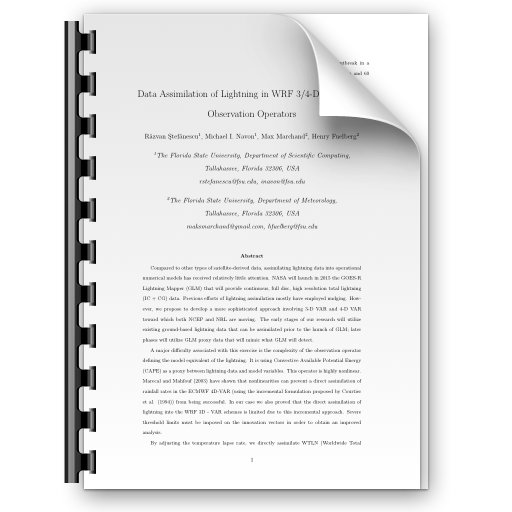
Data Assimilation of Lightning in WRF 3/4-D VAR Using Observation Operators
Abstract
Compared to other types of satellite-derived data, assimilating lightning data into operational numerical models has received relatively little attention. NASA will launch in 2015 the GOES-R Lightning Mapper (GLM) that will provide continuous, full disc, high resolution total lightning (IC + CG) data. Previous efforts of lightning assimilation mostly have employed nudging. How- ever, we propose to develop a more sophisticated approach involving 3-D VAR and 4-D VAR toward which both NCEP and NRL are moving. The early stages of our research will utilize existing ground-based lightning data that can be assimilated prior to the launch of GLM; later phases will utilize GLM proxy data that will mimic what GLM will detect.
A major difficulty associated with this exercise is the complexity of the observation operator defining the model equivalent of the lightning. It is using Convective Available Potential Energy (CAPE) as a proxy between lightning data and model variables. This operator is highly nonlinear. Marecal and Mahfouf (2003) have shown that nonlinearities can prevent a direct assimilation of rainfall rates in the ECMWF 4D-VAR (using the incremental formulation proposed by Courtier et al. (1994)) from being successful. In our case we also proved that the direct assimilation of lightning into the WRF 3D - VAR schemes is limited due to this incremental approach. Severe threshold limits must be imposed on the innovation vectors in order to obtain an improved analysis.
By adjusting the temperature lapse rate, we directly assimilate WTLN (Worldwide Total Lightning Network) total lightning data for the 2011 Tuscaloosa, AL tornado outbreak in a domain of 406 × 305 km2 with a mesh resolution of 1 km in each horizontal direction and 60 vertical levels.
Next we developed a new scheme similar to the one outlined in Marecal and Mahfouf (2002, 2003) i.e., use 1-D VAR to adjust rainfall rate from the moist physics (mass-flux convection scheme and large-scale condensation) closer to an observed value as in Mahfouf et al. (2005). In our case, the 1D-VAR temperature columns retrievals are considered as new observations and are assimilated in the 3D/4D-VAR systems . These approaches are denoted the ’1-DVAR + 3-DVAR’,’1-DVAR + 4-DVAR’ approaches (Mahfouf et al. 2005). It minimizes the problem that nonlinearities of the moist convective scheme can introduce discontinuities in the cost function between inner and outer loops of the incremental 3-D/4-D VAR minimization.
Next we present some results obtained with the 1-DVAR +3-DVAR approach. Again, we applied the scheme for the 2011 Tuscalosa, Al tornado outbreak on a horizontal domain of 100 × 100 km2 with a mesh resolution of 1 km and 60 vertical levels.
The 1-DVAR +4-DVAR approach requires tremendous computational resources at 1km reso- lution. An assimilation window of 6 hours demands 1011 double precision variables to be stored in the virtual memory, which will require 1000 Gbs. Even with I/O checkpoints the computer needs to store 107 variables which make every 4-DVAR run impossible at 1km resolution. One solution will be the split of the assimilation period in small windows with the length of one hour, with the derived 4D-Var problems being solved as new data become available. The release of the parallel version of WRFDA will allow us to test both approaches, the direct lightning assimilation scheme and the 1-DVAR method, in 4-DVAR framework.

